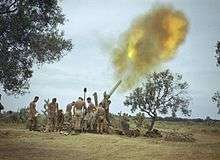BL 4.5-inch Medium Field Gun
| BL 4.5 inch Medium Gun | |
|---|---|
 Gun at Imperial War Museum Duxford | |
| Type | Medium gun |
| Place of origin | United Kingdom |
| Service history | |
| Used by | United Kingdom, Canada |
| Wars | World War 2 |
| Specifications | |
| Weight |
Travel: 15,986 lb (7,251 kg) Action: 12,635 lb (5,731 kg) |
| Barrel length |
15 ft 9 in (4.8 m) 42.8 calibres |
| Crew | 10[1] |
|
| |
| Shell | 55 lb (25 kg) HE |
| Calibre | 4.5 inch (114 mm) |
| Breech | Welin breech and Asbury mechanism |
| Elevation |
60-pdr carriage: 0 to +42° 5.5-inch gun carriage: -5° to +45° |
| Traverse |
60-pdr carriage: 7° 5.5-inch gun carriage: 60°[1] |
| Muzzle velocity | 2,250 ft/s (686 m/s) |
| Maximum firing range | 11.65 mi (18.75 km) |
| Sights | calibrating and reciprocating[1] |
The BL 4.5 inch Medium Gun was a British gun used by field artillery in the Second World War. It had nothing in common with the QF 4.5 inch Howitzer or the QF 4.5 inch AA Gun.
History

By the end of 1930s, the World War 1-era BL 60-pounder of 1905 had reached the end of its usable service life within the ranks of the British Army. A successor was sought and work began on an all-new design that would result in the Ordnance BL 4.5" Medium Field Gun, a long range medium gun designed for counter-battery fire. The gun was in use throughout the Second World War and it equipped a number of medium regiments, including half the Canadian ones.[2] In service, the guns were fielded at the regiment level and were taken on by both British and Canadian artillery field groups during the war.
The 4.5inch (114mm) field gun was a good weapon that could fire a 25kg HE shell up to 11.6 miles with Charge 3. It matched German 10.5 cm and 155 mm howitzers in range and firepower.[3]
For the sake of expediency, Mk 1 ordnance was designed to be mounted on the 60-pounder carriage. The Mk 2 was on a new carriage that was also used with the BL 5.5 inch gun that replaced the 6-inch howitzer. There were slight differences between the Mk 1 and Mk 2 equipment, but the maximum range was almost identical. The Mk 1 gun was first issued in 1938 and equipped one or two regiments of the British Expeditionary Force, where they saw their baptism of fire. They also equipped at least one regiment in the North Africa campaign and some were lost in Greece. The 4.5 inch Mk 1 is sometimes mistaken for the 60-pounder. Both Mks were normally towed by the AEC Matador 4 × 4 medium artillery tractor. The Germans gave captured guns the designation 11.4 cm K 365(e).[1]
In 1941, the 114mm gun was set atop a standardized carriage common to 4.5 inch and 5.5 inch artillery systems. This created the Mk 2 designator. Issues of the Mk 2 ordnance on the common carriage started in 1941 and served in North Africa, Italy and North West Europe. It was withdrawn from field service in 1945, relegated to training purposes and finally declared obsolete in 1959.
The US 4.5 inch gun M1 used the same shell design, Mk 1D in UK service with a 6/10 crh. This design was noted for its small amount of HE (3.9 lb (1.8 kg) in a 55 lb (25 kg) shell) but the larger fragments that resulted were suited to its counter-battery role. Apart from HE, the only other type of shell was flare used to indicate targets for air attack. It had propellant in charges 1, 2 and 3. Intense rate of fire was 2 rounds per minute, normal rate was one round, Gunfire was 2 to 3 rounds per minute.
Variants
- Mark 1
- New 4.5 inch ordnance on 60 pounder carriage introduced in the 1930s used by the Royal Artillery in France and North Africa in the Second World War.
- Mark II
- Modified ordnance on Carriage 4.5 inch and 5.5 inch in use in the Second World War from 1941 by British and Canadian artillery.
See also
- 122 mm gun M1931/37 (A-19) approximate Soviet equivalent
- 10 cm sK 18 approximate German equivalent, smaller caliber
- 4.5 inch Gun M1 United States equivalent, fired same ammunition
- BL 5.5-inch Medium Gun shared carriage
References
- 1 2 3 4 Chamberlain, Peter (1975). Heavy artillery. Gander, Terry,. New York: Arco. p. 40. ISBN 0668038985. OCLC 2143869.
- ↑ https://www.militaryfactory.com/armor/detail.asp?armor_id=883
- ↑ http://ww2f.com/threads/ordnance-qf-25-pdr.61130/
External links
| Wikimedia Commons has media related to BL 4.5 inch Medium Field Gun. |